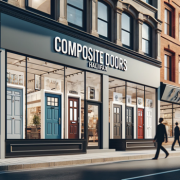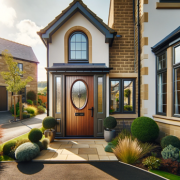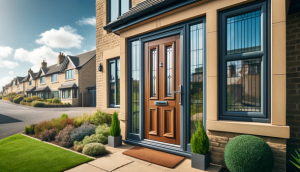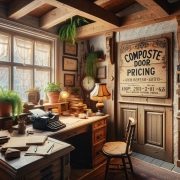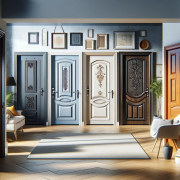Halifax Composite Door Design Trends
Exploring the Evolution of Composite Door Designs in Halifax: Style Meets Functionality
Composite doors are gaining traction in Halifax, not just for their robust security and durability but also for their aesthetic flexibility that complements a variety of home styles. As homeowners look to blend functionality with style, the composite doors design trends in Halifax have evolved to meet these demands. This article explores the current trends in composite door designs, the technological advancements enhancing these doors, and how they align with the unique architectural heritage of Halifax.

Current Trends in Composite Door Designs
Colour Trends
In the dynamic world of home décor, composite doors in Halifax are not left behind, reflecting broader trends in colour, design, and personalisation that cater to both modern and traditional tastes. Recently, there has been a noticeable shift towards bold door colours. Vibrant blues, deep greens, and even daring blacks are becoming popular choices among Halifax homeowners. These colours not only enhance the curb appeal but also reflect a homeowner’s personality and style. Neutral shades like grey and taupe remain popular for their classic appeal and ability to blend with various exterior finishes.
Minimalist and Modern Designs
The trend towards minimalist design is evident in the clean lines and uncluttered appearance of composite doors. This design philosophy suits the contemporary architectural styles emerging in Halifax, where simplicity and functionality are key. Features like flush door surfaces and hidden hardware are characteristic of this trend, offering a sleek, understated look that enhances the modern aesthetic.
Bespoke Customisation
Customisation is another significant trend, as it allows doors to be tailored to specific architectural styles or homeowner preferences. Whether it’s through the use of bespoke glass inserts, unique patterns, or custom-built features, Halifax residents are increasingly opting for doors that reflect their personal style and enhance the individuality of their homes.
Technological Advancements in Composite Door Features
Smart Technology Integration
As technology progresses, so does the functionality of composite doors, making them not only aesthetically pleasing but also smarter and more efficient. Smart locks and access control systems are becoming standard features in composite doors, providing both security and convenience. These systems allow doors to be locked and unlocked remotely via smartphones and include features such as custom access codes and entry tracking, which are particularly appealing for the tech-savvy homeowner in Halifax.
Energy-Efficient Technologies
Energy efficiency remains a priority, and the latest composite doors come equipped with improved insulation materials that significantly reduce heat loss. Innovations such as dense foam cores and energy-efficient frames enhance this attribute further, making the doors even more effective at maintaining internal temperatures. Technologies like thermal breaks and triple-glazing not only contribute to a home’s thermal efficiency but also to its overall energy consumption, aligning with the growing environmental consciousness among Halifax residents. These features help to create a more comfortable living environment by stabilising indoor climates and reducing the reliance on heating and cooling systems, which in turn leads to lower utility bills and a reduced carbon footprint.
Material Innovations
Advanced Fibreglass and Composites
The evolution of composite doors in Halifax continues with significant advancements in the materials used, making these doors not only more aesthetically appealing but also tougher and more environmentally friendly. New developments in fibreglass and composite materials have allowed for greater diversity in door textures and finishes. These materials are engineered to resist weathering better than traditional door materials, ensuring that doors maintain their colour and structural integrity over a longer period of time. Additionally, the versatility of these materials means that they can be designed to mimic other materials like wood or metal, providing a high-end look without compromising on durability or requiring extensive maintenance.
Sustainable Materials
There is an increasing shift towards using sustainable materials in composite doors. Manufacturers in Halifax are incorporating recycled plastics and wood into their doors, reducing the environmental impact of production. These eco-friendly materials not only appeal to environmentally conscious consumers but also contribute to the overall energy efficiency of homes by improving insulation.
Influence of Local Architecture on Door Design
Complementing Historic and Modern Homes
Halifax’s rich architectural heritage plays a crucial role in influencing the design trends of composite doors in the area. Understanding how these doors complement various architectural styles can help homeowners make informed choices that enhance their property’s aesthetic and historical value. For historic Halifax homes, composite doors that feature traditional designs with modern performance are popular. These doors often include elements like classic panel designs and heritage colours that echo the architectural past while incorporating modern security and insulation technologies. Conversely, for newer, more modern structures, homeowners might choose minimalist designs with bold, contrasting colours that make a contemporary architectural statement.
Forecasting Future Trends
Personalisation and Technology
Looking ahead, the design trends in composite doors are set to incorporate more personalised and technologically integrated features, driven by consumer demand and technological advancements. The future will likely see an increase in customisation options, allowing homeowners to design their doors as a reflection of their personal style to an even greater extent. Technological advancements, such as augmented reality apps, could enable customers to visualise these doors in their homes before making a purchase decision. Moreover, integration with home automation systems is expected to become more sophisticated, with features like facial recognition and advanced thermal efficiencies becoming standard.
Material and Design Innovation
Innovation in materials and design is anticipated to continue, with a focus on even greater sustainability and efficiency. This could include the development of new composites that offer better thermal insulation and are made from 100% recyclable materials, appealing to a market that is increasingly driven by environmental concerns.
In conclusion, the composite door market in Halifax is at the forefront of integrating style, security, and sustainability into home design. With a keen eye on current trends and technological advancements, these doors offer more than just an entry point; they enhance the aesthetic, energy efficiency, and security of homes. As materials evolve and technology integrates further, homeowners have the opportunity to choose doors that not only suit their style but also align with environmental values and cutting-edge functionality. Staying informed on these trends ensures that your choice of a composite door is a long-term investment in the comfort and security of your home.






